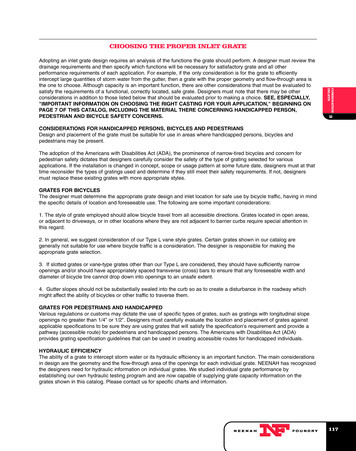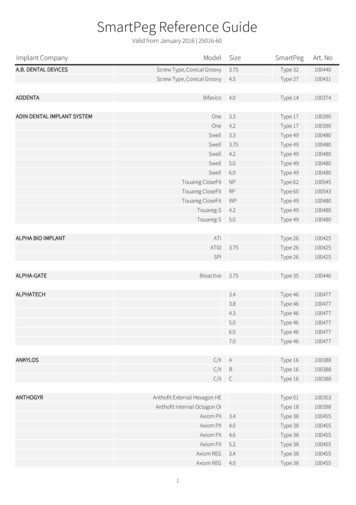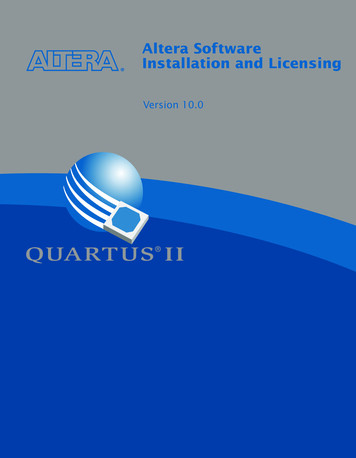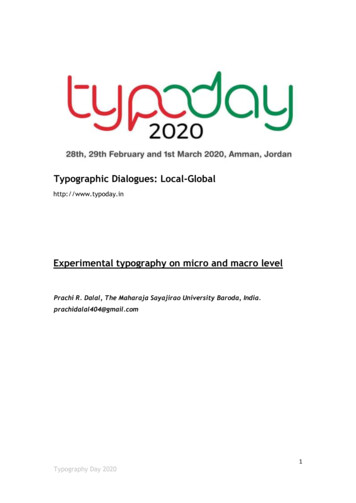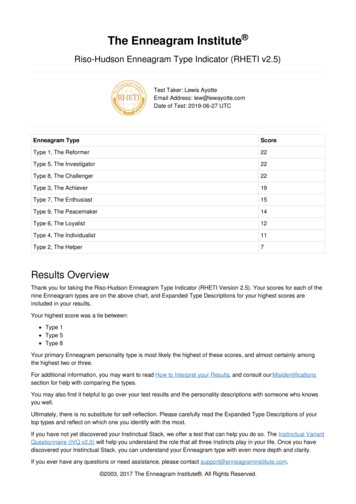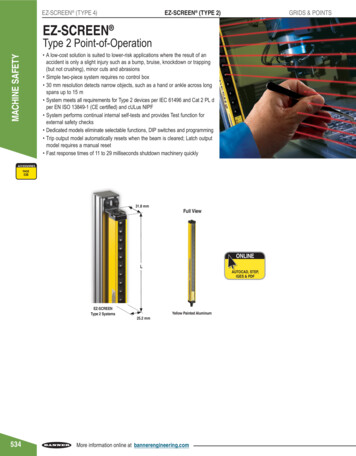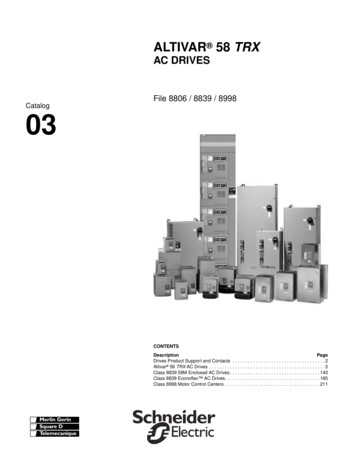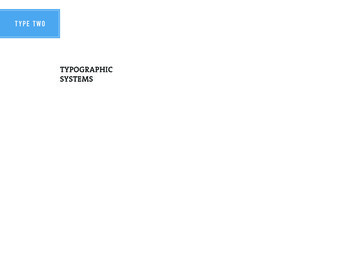
Transcription
T YPE TWOTYPOGRAPHICSYSTEMS
T YPE TWOAXIAL SYSTEMRADIAL SYSTEMAll elements areorganized either to theleft or the right of a singleaxis.All elements extend froma point of focus
T YPE TWODILATATIONAL SYSTEMRANDOM SYSTEMAll elements expandfrom a central point in acircular fashion.Elements appear to haveno specific patter orrelationship.
T YPE TWOGRID SYSTEMTRANSITIONAL SYSTEMA system of vertical andhorizontal divisionsAn informal system oflayered banding.
T YPE TWOMODULAR SYSTEMBILATERAL SYSTEMA series of nonobjective elementsthat are constructed asstandardized units.All text is arrangedsymmetrically on a singleaxis.
T YPE TWOExplore these systems in a process-oriented exploration. Wewill work with these in two ways. First, a series of compositionsconstrained to one size and one weight of type. The second is a seriesof compositions with the option to use object elements and changesin tone.
T YPE TWOThe same eight-line message is used in all of the compositions inorder to focus attention on the variations in the visual organizationsystems.
T YPE TWO
T YPE TWOAll lines must be used in each composition. However, lines may bebroken at will to change a single line into multiple lines, creatingchanges in grouping and the way in which the line is read.
T YPE TWOLeading is variable, which in turn creates changes in position andtextures.Variable word spacing and letter spacing creates distinct changesin texture and tone.
T YPE TWOLINE BREAKSLines may be broken at willto make multiple lines.LEADINGLeading can be tight/negative or wide and airy.WORD AND LETTER SPACEVarying word spacingand letter spacing createsdifferent textures.
T YPE TWOOBJECT ELEMENTS(NON TYPOGRAPHIC INFORMATION)Just as typography is functional in the communication of a message,object elements enhance the functions of emphasis, organization,and balance. Object elements become functional guides whenused with typography and communicate the message differentlyby highlighting elements of a hierarchical order and directing theviewier’s eye.In addition these elements can strengthen a message bycommunicating a sense of organization and direction.
T YPE TWOOBJECT ELEMENTS(NON TYPOGRAPHIC INFORMATION)RULE SERIES
T YPE TWOOBJECT ELEMENTS(NON TYPOGRAPHIC INFORMATION)CIRCLE SERIES
T YPE TWOOBJECT ELEMENTS(NON TYPOGRAPHIC INFORMATION)TONE SERIES
T YPE TWOAXIAL SYSTEMThe axial system is one of the simplest systems. Allelements are organized either to the left or right ofa single axis. This is a branching arrangement froman implied main line. The axis can exist anywherein the format to create a symmetric or asymmetriccomposition. Examples of axial arrangements innature include the trunks of trees, flower stems,and many other plants.Experience working with the axial system revealsthat asymmetric arrangements are often moreinteresting than symmetrical ones. When the axisis placed off center to the left or right the space isdivided in a more interesting way, with a shift inthe proportion of larger and smaller volumes ofspace. The use of asymmetry results in a relativelysimple visual arrangement with heightened visualinterest.
T YPE TWOAXIAL SYSTEMWhile many axial system compositionsbenefit from asymmetric placement,this poster employs the symmetry ofthe centered axis to evoke and celebratethe simplicity of Le Corbusier’s modernarchitecture. The single-axis typographicarrangement splits the poster and theglossy center square over the face. Thephotographic image provides asymmetricaccent in the hand that lifts the architect’ssignature geometric glasses. Two finewhite horizontal line that bisects theglossy square and focuses the viewer’s eyeon the image.
T YPE TWOAXIAL SYSTEMEmil Ruder1960
T YPE TWOAXIAL SYSTEMEmil Ruder1960
T YPE TWOAXIAL SYSTEMEmil Ruder1960
T YPE TWOAXIAL SYSTEMOdermatt & Tissi1980
T YPE TWOAXIAL SYSTEMNarrow columnwidths
AXIAL SYSTEMNarrow columnwidths
AXIAL SYSTEMNarrow columnwidths
AXIAL SYSTEMNarrow columnwidths
AXIAL SYSTEMWideColumn widths
AXIAL SYSTEMWideColumn widths
TRANSPARENCY
TRANSPARENCY
Impliedshapedaxis
Explicitshapedaxis
Diagonalaxis
Diagonalaxis
T YPE TWORADIAL SYSTEMIn the radial system all elements are organizedto extend from a central point of focus like rays.Examples include the petals of flowers, fireworks,domes In architecture, rays of the sun, spokes of awheel, starfish, etc. The compositions are dynamic,as the eye is drawn to the focal point of the radialcomposition. This point can be implied or depicted.Depending on the orientation of the lines,readability of the message may be diminished asthe type leaves the traditional horizontal baseline.Within this system lines of text can be arranged toread in a number of different ways: top to bottom,bottom to top, right side up, or upside down. Inorder to create a functional message, the lines oftext should be arranged in the most comfortablemanner possible.When working with text, the resultingcompositions often contain portions of a singlecircle or many circles. The resulting asymmetry isless satisfying and more visually interesting.
T YPE TWORADIALSYSTEMINSECTPaul Humphreyand Luke Davies1998In the Old Truman Brewery poster theradial system is used to communicate thattransformation of an inductrial warehouseto “a centre for young design talent sosharp it could cut diamonds.” The text isarranged around a centre focus point and astrong horizontal line, and sharp angles oftext slice the collaged images in dynamicpinwheel fashion.The radial system becomes the foil forcommunicating the dynamic intent that isfocused on the building. Lines of text movetoward the centre point and then radiateout as a fitting tribute to the design talenthoused within and the effect they willhave on the community.
RADIALSYSTEM
T YPE TWORADIALSYSTEMThe radial systemimmediately presents acompositional challengebecause each line mostreadily exists as anindividual unit with arelationship only withthe focal point.
e Artshool of thcSegelloCraagnLaCommunication Ae enttivac artmernt DepdIan tionhic icaap unGr mmCoFeFe bFe b ruabr rua ryua ry 8ry 15 , 222 , 2 012, 2 0101 22RADIAL SYSTEMemphasisstrategiesFrPu eeLe bliccture7:0Lib 0ra pmryHallrts Program
FrPu eeLe blicctureRADIAL SYSTEMemphasisstrategies7Lib:00ra pmryHachoolLangara College SCommunication Ae enttivac artmernt DepdIan tionhic icaap unGr mmCoFeFe bFe b ruabr rua ryua ry 8ry 15 , 222 , 2 012, 2 0101 22llrts Pof the Artsrogram
FrPu eeLe blicctureRADIAL SYSTEMemphasisstrategies7Lib:00ra pmryHachoolLangara College SCommunication Ae enttivac artmernt DepdIan tionhic icaap unGr mmCoFeFe bFe b ruabr rua ryua ry 8ry 15 , 222 , 2 012, 2 0101 22llrts Pof the Artsrogram
RADIAL SYSTEMgroupingstrategies
7:00 pmnoitaci amnu grm room s PC rtegAelloCarasgtrALanethfoloSchoraG m12Cory 8, 20Februa ry 15, 2012Februa ry 22, 2012FebruaLibrary HallFrPu eeLe blicctureRADIAL SYSTEMGROUPINGSTRATEGIESnive ect tmra arte epIn n Ddan tioic icaph unmt
veRADIAL SYSTEMrules andhierarchytneti rtmcra paeetIn n Dd iona atreNuc ictiOMIh unecATpLa mRICArciGlG ombEOUNuGCPRE EPeLMeL THFrOTSOMCASTRAR C ARAOL OFG HONLA SCllmp07:0LiHayrbra0122,51yraFebruFebruary 22, 2012February 8, 2012
RADIAL SYSTEMrules andhierarchy
RADIAL SYSTEMrules andhierarchy
RADIAL SYSTEMtransparentplanes
T YPE TWODILATATIONAL SYSTEMIn a dilatational system circles dilateor expand from a central point. Anexample of this system is the wavescreated when a pebble is dropped intostill water. Similar to the radial system,the compositions are dynamic as theeye moves along the arc of the circleor is drawn to the focal point at thecentre of the circle.The simplest forms of thedilatational system are circles thatexpand in regular or rhythmicalincrements from the center. Variationsof this system can include dilationsthat are tangent, dilations that arenon-concentric, and multiple dilations.
T YPE TWODILATATIONALSYSTEMStein und Ottwww.ott-stein.de
DILATATIONALSYSTEMstructure
DILATATIONALSYSTEMstructure
DILATATIONALSYSTEMstructure
DILATATIONALSYSTEMstructure
DILATATIONALSYSTEMobject elements
DILATATIONALSYSTEMobject elementsLangS C H O O L O F T H ara CollegEGRAPHIC ANAD INeRecLtcuilrebTTuPER SAF re e 0 0 p m L i b r a r PARPRDESONRTu2 201,brFebruary 2Februa 2,ry 2015 18, 2012ary
DILATATIONALSYSTEMaxis
DILATATIONALSYSTEMaxis
DILATATIONALSYSTEMaxis
T YPE TWORANDOM SYSTEMThe random system consists of elements that arearranged without definite aim, pattern, direction,rule, method or purpose, but it is deceptivelysimple because the viewer imposes organizationon compositions even when it is unintentional.The human eye and brain are keenly programmedto be pattern-seeking, image-seeking, and orderseeking. For centuries humans have found imagesin the constellations of stars in the sky or In cloudformations.Work is often begun by scattering elements in thecompositional field with free abandon. Inevitably,some of those elements align and the compositionfeels intentional. Success is more frequent whenlegibility diminishes with cropping, overlapping,and placing text at odd angles, which are cues ofrandomness. Surprisingly, random placement oftenyields a very dynamic and spontaneous result that,although difficult to read, is visually satisfying.
T YPE TWORANDOM SYSTEMMakoto Saito1994
T YPE TWORANDOM SYSTEMDavid Carson1997
RANDOMSYSTEM
RANDOMSYSTEMobjectelements
GraFebruary15, 2012phicFe22 brua, 2 ry012mComuntaciionArtsPrFree Public LectureehtfInteorac olotive ChommcSunmAndrogatsrAm7:00 picationFebruary8, 2012LibraryHallLangara CollegeRANDOMSYSTEMobjectelementsDepartment
oolof theArtsnragaCeollge7:00 pmic AndInteractive Communication DepartmentFe15 bru, 2 ary012CommucniationtArsProagrmFebruary22, 2012aryHallryaubrFe 1220,8GraphLaLibrSchF re e P u blic LectureRANDOMSYSTEMshapedbackground
RANDOMSYSTEMrepetition
T YPE TWOGRID SYSTEMA grid is a system of vertical and horizontaldivisions that organize and createrelationships between elements. Gridsystem arrangements are usually formaland are intended to create visual orderand economy in production. Grids arefrequently used in publication design andweb design as they guide informationhierarchies and promote visual rhythmand consistency among multiple pages orscreens.The objective in organizing visualcommunication with the grid system is todevelop strong interrelationships betweenthe typographic elements and recurringrhythmical proportions of text blocks,images, and space. Grid systems differfrom the axial system in that the visualrelationships are not tied to a single axisand usually employ more than a singlecolumn.
T YPE TWOTRANSITIONAL SYSTEMThe transitional system of visualorganization is an informal system oflayered and shifted banding. There are notinterrelationships along an axis or edgealignments, and elements move freelyleft and right. This is a far more casualsystem than the grid system in that strictinterrelationship through edge alignmentis not desirable. The lines of type are freeflowing and the textures they create assistin ordering the message. Examples ofnatural transitional arrangements includestrata of layered rock or casually stackedwood.Compositions can be airy and widelyleaded or tightly compact, whichemphasizes the negative space. Thissystem often results In compositions thatecho fine art in that many have the visualfeel of a landscape. which is admittedlyenhanced by the use of the circle elementthat becomes an abstract sun or moon.
T YPE TWOTRANSITIONALSYSTEMDavid Carson1996
TRANSITIONALSYSTEMmovement
LangaraCollegeSchool of the ArtsGraphic And Interactive Communication e7:00pmLibrary HallFebruary 8, 2012February 15, 2012February 22, 2012TRANSITIONALSYSTEMmovement
TRANSITIONALSYSTEMmovement7:00 pmLibrary HallFebruary 22, 2012February 8, 2012February 15, 2012FreePublicLectureLangara CollegeSchool of the ArtsGraphic And Interactive Communication DepartmentCommunicationArtsProgram
TRANSITIONALSYSTEMmovementFreeFebruary2P Feb 2, 2ub ru 01La l i ary 2FeC Schnga c 15, bruo20 arrm ool a C1of o L 2 y 8, 2m01u Gt h e l l e g e cn ra A e t2i c p rturea hic sti Ao ndnInteA racr t tivesCP7:0Lib 0 pmrary HaomrogmunraicmationDepartmentll
TRANSITIONALSYSTEMchange indirection7:00 pmLibrary HallFreeFebruary 22, 2012February 8, 2012February 15, 2012PublicLecturementLangara CollegeSchool of the ArtsGraphic And Interactive Communication DepartCommunicationArtsProgram
CommunicaTRANSITIONALSYSTEMchange indirectiontion7:00 pmLibrary HallArtsProgramFebruary 22, 2012February 8, 2012February 15, 2012FreePublicLectureLangara CollegeSchool of the ArtsGraphic And Interactive Communication Department
TRANSITIONALSYSTEMmovement
TRANSITIONALSYSTEMmovementLANGARA COLLEGESCHOOL OF THE ARTSGRAPHIC AND INTERACTIVE COMMUNICATION DEPARTMENTCOMMUNICATION ARTS PROGRAMFREE PUBLIC LECTURE7:00 PMLIBRARY HALLFEBRUARY 8, 2012FEBRUARY 15, 2012FEBRUARY 22, 2012
TRANSITIONALSYSTEMmovementLANGARACOLLEGELANGARA COLLEGESCHOOLOFTHEARTSSCHOOLOFTHEARTSGRAPHIC ANDERACTIVE COMGRAPHICAND INTINTERACTIVECOMMUNICATIONDEPARTMENTMUNICATION DEPARTMENTCOMMUNICATION ARTS TUREFREELECTURE7:007:00 PMPMLIBRARY HALLLIBRARYHALLFEBRUARYFEBR ARY 8,8, 20122012FEBRUARYU15,FEBRUARY201215,201FEBRUARY 22,FEBRUARY22, 20122012 2
T YPE TWOMODULAR SYSTEMThe modular system is dependent onstandardized nonobjective elements orunits that act as a ground to hold andcontain text. Compositions are createdby the organization and placement of themodular units.Typographic lines and words havea distinctly individual form that defystandardization and require a module thatacts
communication with the grid system is to develop strong interrelationships between the typographic elements and recurring rhythmical proportions of text blocks, images, and space. Grid systems differ from the axial system in that the visual relationships are not tied to a single axis and usually employ more than a single column.
